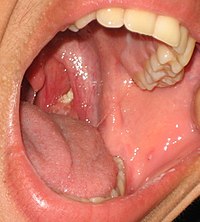
Photo from wikipedia
Introduction: Different methods to characterize bacterial biofilms have been established, each presenting with distinct advantages and shortcomings. The aim of this study was to validate the ability of microbiological culture,… Click to show full abstract
Introduction: Different methods to characterize bacterial biofilms have been established, each presenting with distinct advantages and shortcomings. The aim of this study was to validate the ability of microbiological culture, the adenosine‐5′‐triphosphate (luminescence) assay, molecular, and microscopic methods to assess antibiofilm efficacy. Methods: Thirty‐nine extracted single‐rooted teeth were selected. Enterococcus faecalis biofilms were grown for 21 days and randomly distributed into 3 groups. All canals were instrumented (F3 ProTaper Universal; Dentsply Sirona, Johnson City, TN) and irrigated (ProRinse needles, Dentsply Sirona) as follows: group 1, sodium hypochlorite and EDTA irrigation; group 2, supplemented with sonic agitation of NaOCl, and group 3, sterile distilled water irrigation. Bacteriologic samples were collected before (S1) and after canal preparation (S2) and subjected to quantification by culture methods, quantitative reverse transcriptase real‐time PCR (qRT‐PCR), and luminescence assay. The biofilm structure and bacterial cell viability were evaluated under scanning electron microscopy (SEM) and confocal laser scanning microscopy (CLSM). Data were subjected to statistical analysis to determine the statistical significance (P < .05). Results: S1 samples showed approximately 8‐log colony‐forming‐units of bacteria using both culture and qRT‐PCR. The reduction in bacterial population and relative luminescence was highly significant in the S2 samples from groups 1 and 2 (P < .001). SEM and CLSM showed well‐matured root canal biofilms in the pretreatment samples that were reduced after treatment. Irrigation with NaOCl combined with sonic agitation significantly decreased the percentage of live cells (P < .05) but was not able to eliminate the biofilm structure. Conclusions: This study highlighted the maximum reduction of microbes after instrumentation‐syringe irrigation. Although supplementary sonic agitation reduced the root canal biofilm further, it did not completely eliminate the biofilm from a single root canal model. The merits of combining microbiological and molecular quantification methods with CLSM for the comprehensive assessment of antibiofilm efficacy in root canals were emphasized. Highlights:Both microbial quantification and microscopy are essential for biofilm assessment.Instrumentation‐syringe irrigation produced the maximum microbial reduction in root canals.Sonic agitation after syringe irrigation reduced the biofilm contents from the root canal wall.
Journal Title: Journal of Endodontics
Year Published: 2018
Link to full text (if available)
Share on Social Media: Sign Up to like & get
recommendations!